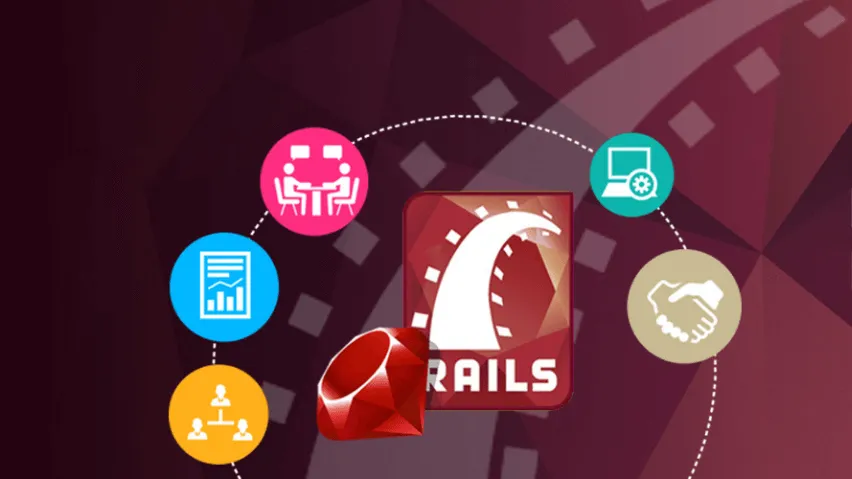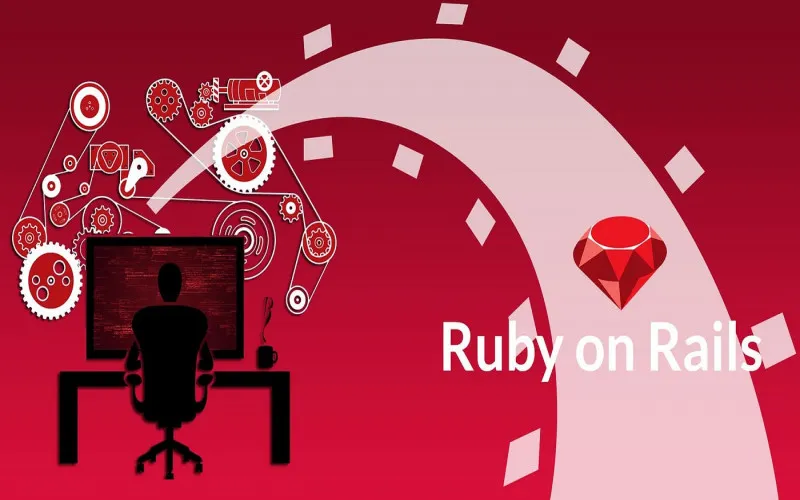Mastering Ruby on Rails A Comprehensive Guide for Beginners
In the ever-evolving world of web development, Ruby on Rails has firmly established itself as a powerful and versatile framework. With its intuitive syntax, extensive ecosystem, and emphasis on rapid development, Rails has become a popular choice for developers looking to create dynamic, scalable, and feature-rich web applications. Whether you’re a seasoned programmer or a newcomer to the field, understanding the intricacies of Ruby on Rails can be a game-changer in your career.
Understanding the Foundations of Ruby on Rails

What is Ruby on Rails?
Ruby on Rails, often referred to simply as Rails, is an open-source web application framework written in the Ruby programming language. It was created by David Heinemeier Hansson in the mid-2000s and has since gained widespread adoption in the web development community. Rails follows the Model-View-Controller (MVC) architectural pattern, which separates an application’s logic into three interconnected components: the model (data access and business logic), the view (user interface), and the controller (request handling and flow control).
The Benefits of Using Ruby on Rails
- Rapid Development: Rails emphasizes the “Convention over Configuration” principle, which means that it provides sensible defaults for many common web development tasks. This allows developers to focus on writing the core business logic of their application rather than spending time on boilerplate code.
- Ruby’s Flexibility: Ruby, the programming language underlying Rails, is known for its expressive and versatile syntax, making it a joy to work with. Developers can write concise, readable, and maintainable code that is often more compact than its counterparts in other languages.
- Vibrant Ecosystem: The Rails community is large and active, with a wealth of third-party libraries (known as “gems”) available to extend the functionality of your application. This ecosystem ensures that you can find solutions to common problems without having to reinvent the wheel.
- Scalability: Rails applications are designed to be scalable, both in terms of performance and complexity. The framework provides built-in support for caching, background processing, and other techniques that help handle high traffic and complex requirements.
- Security: Rails has a strong focus on security, with built-in protection against common web application vulnerabilities, such as cross-site scripting (XSS), cross-site request forgery (CSRF), and SQL injection.
Getting Started with Ruby on Rails
To begin your journey with Ruby on Rails, you’ll need to set up your development environment. This typically involves installing Ruby, Rails, and a database management system (such as SQLite, PostgreSQL, or MySQL). Once your environment is set up, you can start building your first Rails application using the command-line tool,
.
Navigating the Rails Ecosystem
Understanding the MVC Architecture
The Model-View-Controller (MVC) architectural pattern is the foundation of Rails. It separates an application’s logic into three interconnected components:
- Model: The model represents the data and the business logic of your application. It is responsible for interacting with the database, validating data, and encapsulating the application’s core functionality.
- View: The view is responsible for rendering the user interface and presenting data to the user. It typically consists of HTML templates, CSS styles, and JavaScript code.
- Controller: The controller acts as the intermediary between the model and the view. It handles incoming requests, processes data, and decides what to display to the user.
By separating these concerns, the MVC pattern promotes modularity, testability, and maintainability in your Rails applications.
Routing and URL Generation
Routing in Rails maps URLs to controller actions, allowing users to navigate your application. The
file is where you define your application’s routes, specifying the URL patterns and the corresponding controller actions to handle them.
Rails also provides helpful methods for generating URLs within your application, such as
and
. These methods allow you to create links and URLs that are automatically updated when your application’s routing changes, promoting consistency and maintainability.
Active Record: The ORM of Choice
Active Record is the default Object-Relational Mapping (ORM) library used in Rails. It provides an abstraction layer over the underlying database, allowing you to interact with your data using Ruby objects instead of raw SQL queries. Active Record handles tasks such as database migrations, associations, validations, and query building, making it easier to work with your application’s data.
Migrations and Database Management
Rails’ migration system allows you to manage changes to your application’s database schema over time. Migrations are versioned, making it easy to track and roll back changes as needed. This approach to database management promotes collaboration, version control, and consistency across different environments.
Views and Templating
The view layer in Rails is responsible for rendering the user interface. Rails uses a templating language called ERB (Embedded Ruby) to mix HTML and Ruby code, allowing you to dynamically generate web pages. Views can also leverage Rails’ built-in helpers, partials, and layouts to create reusable and modular user interfaces.
Asset Pipeline and Front-end Development
Rails includes an Asset Pipeline, which is a set of tools and conventions for managing and processing static assets, such as CSS, JavaScript, and images. The Asset Pipeline handles tasks like minification, concatenation, and caching, optimizing the delivery of these assets to the client.
While Rails primarily focuses on the server-side logic, it also supports front-end development through various tools and libraries, such as Webpack, Stimulus.js, and Turbolinks, which can be integrated into your Rails application.
Mastering Rails Conventions and Patterns

Convention Over Configuration
One of the fundamental principles of Rails is “Convention over Configuration,” which means that Rails provides sensible defaults for many common web development tasks. This approach reduces the amount of boilerplate code you need to write, allowing you to focus on the unique aspects of your application.
By following Rails’ conventions, you can leverage the framework’s built-in functionality and avoid the need to manually configure every aspect of your application. This can significantly speed up the development process and make your code more consistent and maintainable.
Active Record Conventions
Active Record, the ORM used in Rails, follows a set of conventions that govern how your application’s models and database tables should be named and structured. For example, Active Record expects your model names to be singular and your table names to be plural, following the pattern
(model) and
(table).
Understanding and adhering to these conventions can help you take full advantage of Active Record’s features, such as automatic table mapping, database migrations, and association definitions.
Routing Conventions
Rails’ routing system also follows a set of conventions, which can help you create more intuitive and consistent URLs for your application. For example, Rails expects resource-based routes to follow the pattern
,
,
, and so on.
By embracing these routing conventions, you can ensure that your application’s URLs are easy to understand and maintain, making it easier for both developers and users to navigate your application.
RESTful Controllers
Rails encourages the use of RESTful (Representational State Transfer) controllers, which align with the HTTP protocol’s standard methods (GET, POST, PUT, DELETE) and the CRUD (Create, Read, Update, Delete) operations. This approach promotes consistency, scalability, and maintainability in your application’s codebase.
RESTful controllers provide a clear and structured way to handle the different actions and responsibilities of your application, making it easier to reason about the flow of data and the user interactions within your application.
Dependency Management with Bundler
Bundler is the de facto standard for managing dependencies in a Rails application. It allows you to specify the gems (third-party libraries) your application requires and ensures that the correct versions of these gems are installed across different environments.
By using Bundler, you can ensure that your application’s dependencies are consistent and up-to-date, reducing the risk of compatibility issues and making it easier to collaborate with other developers on the same project.
Developing Robust Rails Applications

Testing and Test-Driven Development (TDD)
Rails places a strong emphasis on testing, providing built-in support for various testing frameworks, such as RSpec and minitest. By writing comprehensive tests, you can ensure the reliability and correctness of your application, as well as facilitate refactoring and ongoing maintenance.
Test-Driven Development (TDD) is a popular approach in the Rails community, where you write the tests before implementing the actual functionality. This helps you to better understand the requirements, design your application’s logic more effectively, and reduce the risk of introducing bugs.
Handling Asynchronous Tasks with Background Jobs
Rails provides mechanisms for handling asynchronous tasks, such as sending emails, processing large data sets, or integrating with external services. These tasks can be offloaded to background jobs, allowing your application to respond quickly to user requests while the asynchronous tasks are processed in the background.
Popular background job libraries used in Rails include ActiveJob, Sidekiq, and Resque, each with its own strengths and features.
Security Considerations
Rails has built-in security features to help protect your application from common web vulnerabilities, such as cross-site scripting (XSS), cross-site request forgery (CSRF), and SQL injection. However, it’s essential to stay informed about the latest security best practices and to keep your application and dependencies up-to-date.
Some key security practices in Rails include input validation, secure password storage, and proper configuration of headers and other security-related settings.
Caching and Optimization
Caching is a crucial aspect of building high-performance Rails applications. Rails provides various caching mechanisms, such as fragment caching, page caching, and Russian Doll caching, which can significantly improve the response times of your application.
Additionally, Rails offers tools and techniques for optimizing the performance of your application, including database indexing, asset optimization, and server-side rendering.
Deployment and Scalability
Deploying and scaling a Rails application involves various considerations, such as the choice of hosting platform, the use of load balancers, and the implementation of asynchronous processing and caching. Rails supports various deployment strategies, including traditional server-based deployments and containerized solutions like Docker.
As your application grows in size and complexity, you may need to explore more advanced scaling techniques, such as database sharding, content delivery networks (CDNs), and cloud-based infrastructure.
Conclusion
Ruby on Rails is a powerful and versatile web application framework that has gained widespread adoption in the web development community. By understanding the foundations of Rails, navigating its ecosystem, and mastering its conventions and patterns, you can unlock the full potential of this framework and build robust, scalable, and secure web applications.
Whether you’re a seasoned developer or a newcomer to the field, investing time in learning Ruby on Rails can be a game-changer in your career. With its emphasis on rapid development, its vibrant ecosystem, and its strong focus on best practices, Rails can help you deliver high-quality, maintainable, and innovative web applications.
As you continue your journey with Ruby on Rails, remember to stay curious, embrace the framework’s conventions, and leverage its powerful features to create solutions that meet the evolving needs of your users. With dedication and persistence, you can become a proficient Rails developer and contribute to the growth and success of the Rails community.